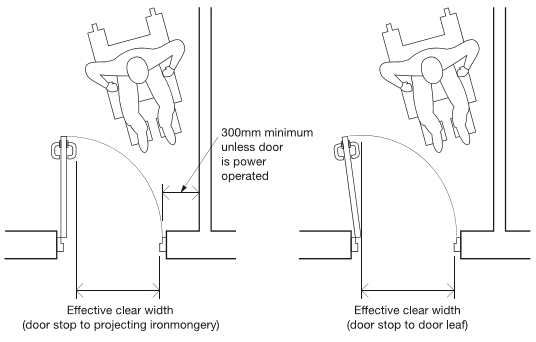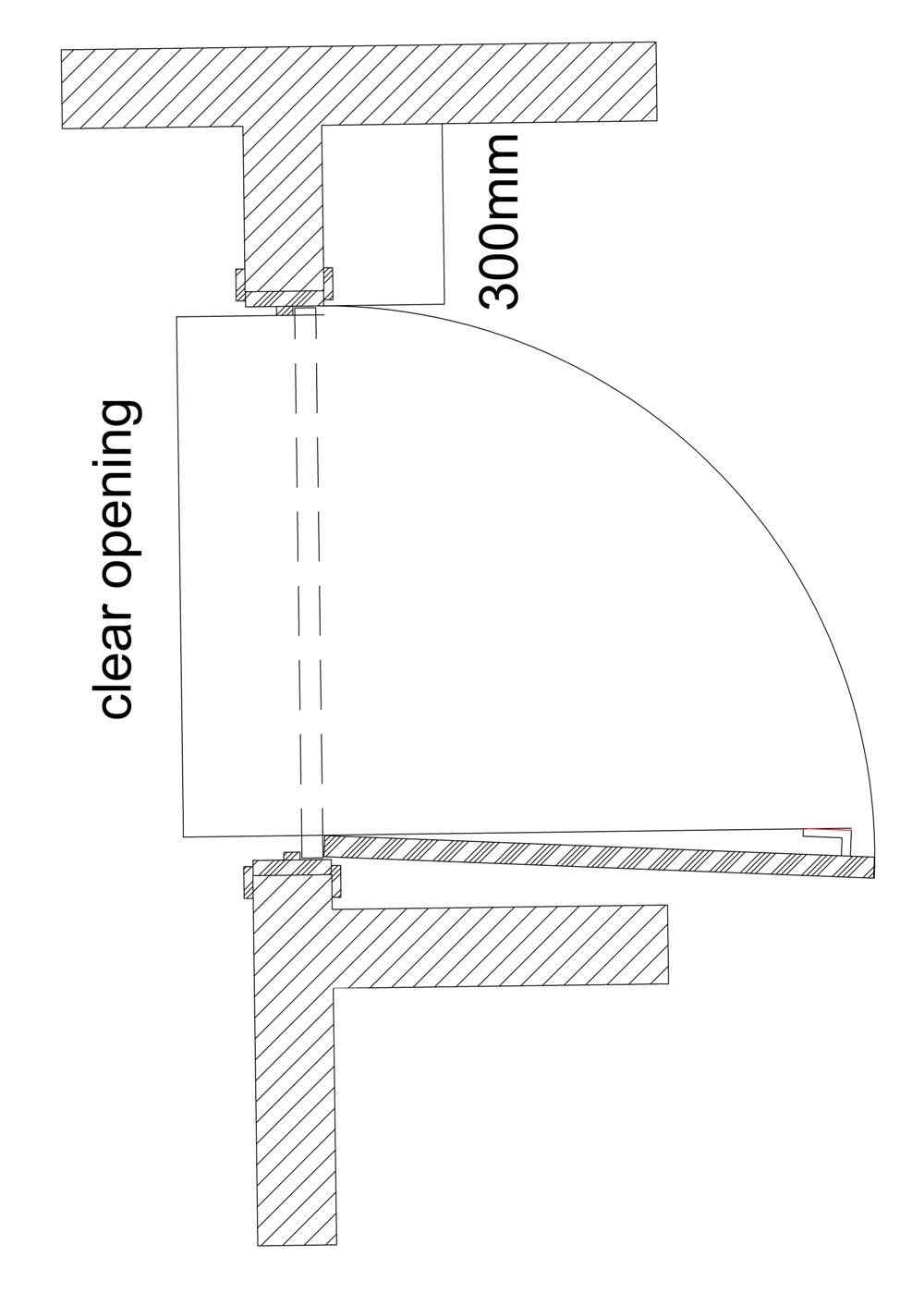Door clear opening width
Approved document M, ‘Access to and use of buildings', requires that a minimum clear width is provided by door openings.
According to the approved document, the effective clear width of a door ‘…is the width of the opening measured at right angles to the wall in which the door is situated from the outside of the door stop on the door closing side to any obstruction on the hinge side, whether this be projecting door opening furniture, a weather board, the door or the door stop’
The minimum allowable clear opening widths for dwellings are set out below:
| Doorway clear opening width (mm) | Corridor clear passageway width (mm) |
| 750 or wider | 900 (when approached head on) |
| 750 | 1200 (when approach is not head-on) |
| 775 | 1050 (when approach is not head-on) |
| 800 | 900 (when approach is not head on) |
For buildings other than dwellings, the minimum allowable clear opening widths are:
| Direction and width of approach | New buildings (mm) | Existing buildings (mm) |
| Straight-on | 800 | 750 |
| At right angles to an access route at least 1,500 mm wide | 800 | 750 |
| At right angles to an access route at least 1,200 mm wide | 825 | 775 |
| External doors to buildings used by the general public. | 1000 | 775 |
The clear opening width can be calculated as:
- The width of the door leaf.
- Plus the gap between the leading edge of the door and the frame when the door is closed.
- Minus the width of the door stop at the leading edge of the door.
- Minus the thickness of the door leaf (or the door stop if that is wider).
- Minus the width of any obstructing door furniture (such as the door handle) that projects into the opening when the door is open. If the door opens to more than 90°, door furniture may not obstruct the clear opening width.
Unless a door is powered, there must be a 300 mm nib beyond the leading edge of the door to allow wheelchair users to properly access the handle.
[edit] Find out more
[edit] Related articles on Designing Buildings Wiki
Featured articles and news
The UK's Modern Industrial Strategy: A 10 year plan
Previous consultation criticism, current key elements and general support with some persisting reservations.
Building Safety Regulator reforms
New roles, new staff and a new fast track service pave the way for a single construction regulator.
Architectural Technologist CPDs and Communications
CIAT CPD… and how you can do it!
Cooling centres and cool spaces
Managing extreme heat in cities by directing the public to places for heat stress relief and water sources.
Winter gardens: A brief history and warm variations
Extending the season with glass in different forms and terms.
Restoring Great Yarmouth's Winter Gardens
Transforming one of the least sustainable constructions imaginable.
Construction Skills Mission Board launch sector drive
Newly formed government and industry collaboration set strategy for recruiting an additional 100,000 construction workers a year.
New Architects Code comes into effect in September 2025
ARB Architects Code of Conduct and Practice available with ongoing consultation regarding guidance.
Welsh Skills Body (Medr) launches ambitious plan
The new skills body brings together funding and regulation of tertiary education and research for the devolved nation.
Paul Gandy FCIOB announced as next CIOB President
Former Tilbury Douglas CEO takes helm.
UK Infrastructure: A 10 Year Strategy. In brief with reactions
With the National Infrastructure and Service Transformation Authority (NISTA).
Ebenezer Howard: inventor of the garden city. Book review.
The Grenfell Tower fire, eight years on
A time to pause and reflect as Dubai tower block fire reported just before anniversary.
Airtightness Topic Guide BSRIA TG 27/2025
Explaining the basics of airtightness, what it is, why it's important, when it's required and how it's carried out.
Construction contract awards hit lowest point of 2025
Plummeting for second consecutive month, intensifying concerns for housing and infrastructure goals.
Understanding Mental Health in the Built Environment 2025
Examining the state of mental health in construction, shedding light on levels of stress, anxiety and depression.
The benefits of engaging with insulation manufacturers
When considering ground floor constructions.
Lighting Industry endorses Blueprint for Electrification
The Lighting Industry Association fully supports the ECA Blueprint as a timely, urgent call to action.

























